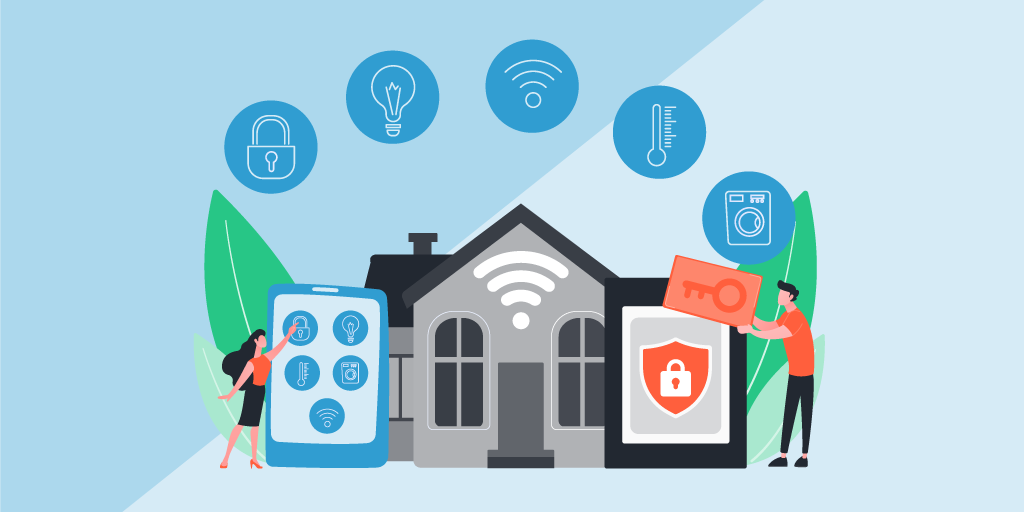
The Internet of Things (IoT) – a vast network of connected devices exchanging data with other devices and systems – revolutionizes how we live and interact with technology. Today’s household has an average of 22 connected devices, and the total number of consumer IoT devices was predicted to be about 8.7 billion in 2022. The modern home is wired with a lot of intelligence, from security cameras and personal assistants to smartwatches, medical devices, and thermostats.
As more IoT devices enter consumers’ homes, homeowners are increasingly concerned about security and data privacy issues. IoT devices are prime targets for cyber attacks: global IoT malware attacks shot up 77% in the first half of 2022, according to SonicWall’s Cyber Threat Report. It was worse in North America, where the number of attacks ballooned by 222%. There were 6.7 million attacks on IoT devices in the U.S. alone.
Why all the attacks? Weak passwords, outdated software, misconfigurations, poor data protection, and a lack of security knowledge and protocols among consumers leave IoT devices in the home vulnerable. With the number of devices continuing to grow, keeping track of what devices are on the network – and ensuring they are updated and protected at all times – is more challenging than ever.
To that end, device identification technology is crucial for ensuring the security and reliability of IoT devices in today’s smart home. This post will explore critical benefits, challenges, and best practices for telecom providers and system integrators looking to implement device identification technology in their consumer offerings.
What is device identification technology?
Device identification is the process of creating a device’s “fingerprint” that can be used to track its activity and understand what other devices connect to it.
Network administrators can use device identification technology to authenticate and validate firmware updates and software patches and prevent unauthorized network access and manipulation. It helps ensure devices have the proper security policies and protocols.
Challenges of implementing IoT device identification
Because IoT devices come in many different form factors and use a wide variety of operating systems, standardizing device identification techniques is challenging. The technology must be compatible with multiple platforms and manufacturers, as well as the various protocols devices use to connect to the Internet.
There are additional challenges, as well. Due to increasing concerns about data privacy, many devices leverage MAC address randomization – the process of concealing the MAC address of a device by using a random, anonymous device identifier in its place – to prevent anyone from monitoring device activity. To make matters even more complex, the IoT landscape is growing exponentially, with new types of devices being constantly introduced to the market. These factors result in a lack of visibility into connected devices, which makes it difficult, if not impossible, to manage IoT devices effectively or guarantee security.
IoT Devices and Cyber Crime
Meanwhile, hackers have figured out that it can be relatively easy to commit cybercrime using IoT devices. APIs that connect smart devices to the network are often used as entry points to command-and-control centers from which cyber attacks can be launched. SQL injection, distributed denial of service (DDoS) attacks, and man-in-the-middle (MITM) attacks are possible, providing opportunities for bad actors to breach networks.
Another major problem is weak passwords. Many users never change the default passwords of IoT devices, making it easy for cybercriminals to gain access. Even if they change them, 68% of people use the same password for multiple accounts, so if a hacker breaks into one account, they can break into many.
Finally, any unpatched security vulnerabilities in connected devices can be gateways for hackers and cybercriminals to infiltrate the network and wreak havoc. They can also break into corporate networks via IoT devices in the homes of remote employees. Given these threats, IoT device identification is essential to home security.
What to Look for in an IoT device ID solution
The very first step in IoT device identification is discovery. If you can’t see a device on the network, there’s no way to identify or protect it. To that end, a suitable device identification and discovery tool must provide the following critical capabilities:
- Automatically and continuously detects all IoT devices connected to the network.
- Leverages AI and advanced machine-learning techniques to identify and recognize devices passively without credentials.
- Creates and maintains a complete and accurate inventory of all connected devices.
- It goes beyond identifying only the MAC address to reveal the device’s make, model, category, and OS.
- Provides insights into vulnerabilities and required updates and patches.
- Easily integrates with your products via a cloud API or SDK.
Lansweeper meets all of these essential requirements. Using Credential-free Device Recognition (CDR) technology, Lansweeper applies big data, AI, and advanced machine-learning techniques to identify and recognize devices without credentials against a database with billions of devices across various environments. With Lansweeper embedded into your IoT offerings, your customers gain complete visibility into their network-connected devices and the confidence that their networks and data are secure and protected.
Securing the Intelligent, Connected Home
In our digitally enabled world, we increasingly depend on technology daily. Visibility into all of the IoT devices we use throughout the day will be increasingly critical to our security and ability to rely on technology to perform our daily tasks. IoT device recognition is foundational to empowering the smart home and, done well, will help market players create differentiation and gain competitive advantage by providing added value to customers.
Lansweeper makes it easy for telecom providers and system integrators to embed Lansweeper into their products with ready-made SDKs and a robust cloud API. Alternatively, we offer an offline database and on-premise solution to meet the unique requirements of sensitive environments.
Innovate, Scale, and Get to Market Faster
Accelerate your go-to-market by leveraging our embedded technologies.
OEM Products